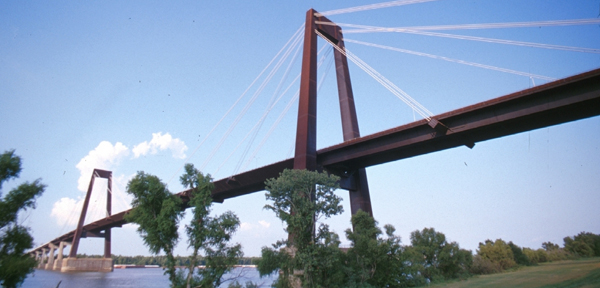
DOTD says concrete deck will advance design in U.S.
Resurfacing the Hale Boggs Memorial Bridge deck isn’t just a $24.5 million upgrade, it’s the result of a 15 year experiment that determined a concrete overlay would provide much longer surface life than asphalt.
“It’s part of the evolution of bridge design,” said Paul Fossier, bridge design engineer administrator with the Louisiana Department of Transportation and Development (DOTD). “Many states in the U.S. will look toward this effort we’re doing and they’ll be keenly interested in doing it if they have similar bridge systems.”
Work is underway to replace the bridge surface, a project expected to continue into June.
When the bridge was opened Oct. 6, 1983, DOTD developed a special asphalt mix for the bridge capable of withstanding Louisiana’s hot summer temperatures and heavy truck traffic, Fossier said. It worked for 10 to 15 years, but DOTD decided that wasn’t enough surface life so it experimented with other deck overlays, including other mixes of asphalt, as well as concrete.
The Hale Boggs bridge is a high traffic or interstate bridge, which poses issues with wear.
“We built these test sections on the bridge, short segments, to try them out,” he said. “Those test sections existed 10 to 12 years and, after that, we decided the concrete test sections would provide that longer life. This is why we’re resurfacing the entire surface with the now tested concrete overlay on only the main cable-stayed bridge section (2,500 feet).”
The concrete test segment lasted 15 years.
Fossier added, not to worry about 4-inch concrete layer being heavier than asphalt, because the bridge was designed for the additional weight.
The cable-stayed design of the Hale Boggs bridge was unique initially, the first and longest of its kind to cross the Mississippi River and second of its kind built in the United States at the time. It was an innovation in the U.S., although they had quickly gained use in Europe and that has happened in the nation, as well.
Fossier said the design was initially chosen for Hale Boggs bridge because of its lower construction and maintenance cost compared to the steel truss bridge design commonly used at the time. For these reasons, the cable-stayed bridge has become the preferred design of today’s structure.
“I think it’s a very aesthetic bridge,” he said. “It’s a cable structure so it’s a very open bridge as opposed to a steel truss bridge. They are becoming the standard for span lengths such as the one for the Luling bridge and the latest example of that is the John James Audubon Bridge in St. Francisville – New Rhodes, which is the second cable stayed bridge in Louisiana and the latest Mississippi River crossing built in the state.”
The bridge cable stays also were modernized.
Although the cable stays had to be replaced on the Hale Boggs bridge a few years back, they were replaced with new innovative stays – the parallel wire strands were replaced by a new cables or seven-wire pre-stressing stands, which Fossier said are easier to replace and work that can be done without shutting down the bridge.




Be the first to comment